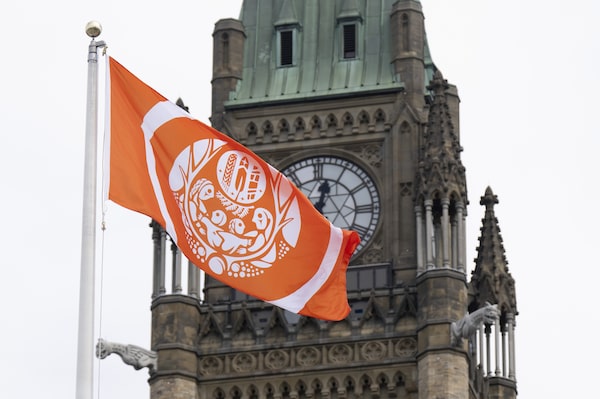
The flag honouring residential school survivors features a family encircled by a cedar branch, eagle feather, Métis sash and inuksuit, as well as seeds nestled below ground, which are meant to represent the spirits of the children who did not return home from residential schools.Adrian Wyld/The Canadian Press
A special flag honouring residential school survivors, as well as the thousands of children who died at the institutions, was raised over Parliament Hill on Monday.
Survivors conceived of the orange and white flag last summer, after several First Nations announced the discovery of unmarked graves on former residential school sites, leading to mourning across the country.
The federal government committed to flying the survivors’ flag last year amid conversations over how – and when – to return Canadian flags to full-mast. Canadian flags were lowered on federal buildings in May, 2021, to mark the announcement by Tk’emlúps te Secwépemc First Nation that it had discovered around 200 probable unmarked graves on the grounds of the former Kamloops Indian Residential School.
The flags ultimately stayed at half-mast for about five months, before they were raised ahead of Indigenous Veterans Day on Nov. 8.
Monday’s flag-raising was attended by survivors, family members, National Centre for Truth and Reconciliation executive director Stephanie Scott, Prime Minister Justin Trudeau, and other federal politicians. In their remarks, survivors emphasized the importance of the flag, while also calling for concrete action from the federal government and Canadians, noting that many of the Truth and Reconciliation Commission’s 94 calls to action have yet to be implemented.
“We need action,” said Jimmy Durocher, a Métis elder and survivor of the Île-à-la-Crosse Boarding School in Saskatchewan, at the event. “It is a responsibility of our government, our churches and our elected people – all of us – to uncover the truth and honour the children.”
The flag features a family encircled by a cedar branch, eagle feather, Métis sash and inuksuit, as well as seeds nestled below ground, which are meant to represent the spirits of the children who did not return home from residential schools.
“The survivors have given us more than a flag. They have reminded us of our collective responsibilities,” Ms. Scott said.
Residential schools operated for more than 150 years in Canada, with the intent of destroying the cultures, languages and family and community bonds of Indigenous peoples. More than 150,000 children attended such institutions, where many were sexually, physically or emotionally abused by the institutions’ staff. The institutions were typically crowded, dangerous and provided children with little in the way of meaningful education.
Pope Francis says genocide took place in Canada’s residential schools
The National Centre for Truth and Reconciliation has documented 4,122 children who died at a residential school – or soon after being sent home or to another institution. “Inconsistent record-keeping and difficulty accessing records” have created challenges to documenting all the children who died, the centre says on its website, and it expects that the number of children listed in the National Student Memorial Register to increase over time, with more research.
Murray Sinclair, the former chair of the Truth and Reconciliation Commission, has said that the true number of children who died at the institutions could be in the 15,000 to 25,000 range.
The flag will fly just west of Centre Block, near the Visitor Welcome Centre, until 2024, when it will go to a permanent home, according to a government press release.
On Monday, Eugene Arcand, a residential school survivor and a Cree from the Muskeg Lake First Nation, implored people to respect the flag – not to bring it to unrelated protests or “use it as a curtain” – as it represents children who died at residential schools.
“It represents the spirit. It represents human beings,” he said. “This flag should fly for as long as these institutions were in place. And if that’s 150 years, then so be it.”
In his remarks, Mr. Trudeau said he was glad that so many people visiting Parliament Hill were able to witness the flag-raising, referring to the dozens of onlookers watching the events from behind a barricade.
“Reconciliation is not just about Indigenous Canadians and government, while Canadians encourage and watch from a distance. Reconciliation is about each and every one of us who live on this land.”
For subscribers: Get exclusive political news and analysis by signing up for the Politics Briefing.